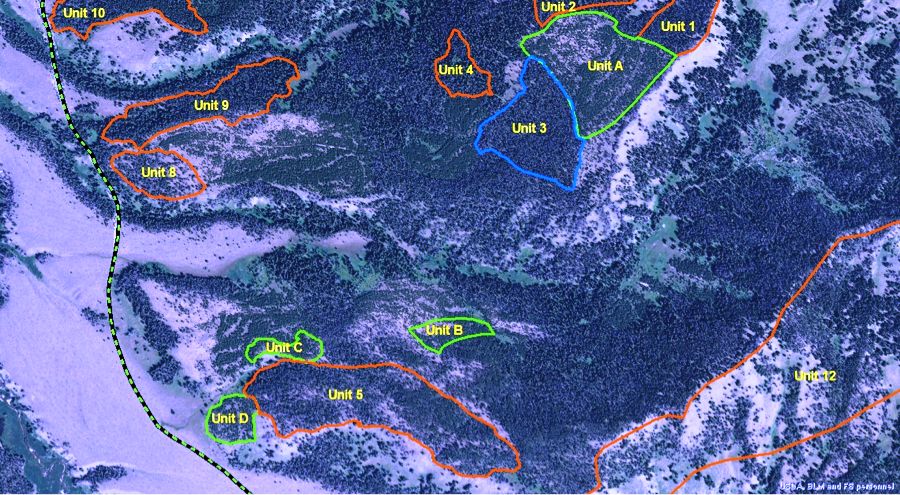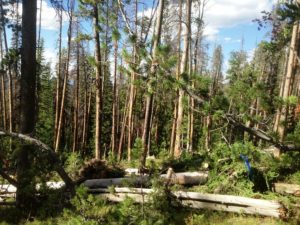2013 Grouse Mountain WBP Restoration Project
Project: Grouse Mountain Whitebark Pine Restoration Project
Agency/Forest or Park/District: Buffalo Ranger District, Bridger-Teton National Forest
Project coordinator: Karl Buermeyer

Contact: Karl Buermeyer, Zone Vegetation Manager, USDA Forest Service, Bridger-Teton National Forest, Blackrock Ranger Station, Moran, WY 83013 Phone: 307-543-3909 Fax: 307-543-9149 kbuermeyer@fs.fed.us
Cooperators
Rocky Mountain Research Station
Source of funding /amount
FHP: $18,000
Supplemental funding: $174,600 from FS PCT funds (NFRR03), FHP MPB, RMRS.
Dates of restoration efforts

July 22 – 31 and September 16 – 28, 2013
Objectives
Proposed treatments would 1) release younger whitebark pine (seedling to pole sized) to improve survival and promote cone-bearing qualities, 2) release mature whitebark pine from competition and reduce risk from fire, bark beetles and white pine blister rust, and 3) create openings in mixed stands to promote natural regeneration. Surviving whitebark pine seed trees will be inventoried and protected with verbenone using FHP MPB funds. Spotty natural regeneration in upper-elevation pure whitebark pine stands with high mortality will be supplemented by interplanting in fall 2013. Monitoring by Rocky Mountain Research Station will assess the effectiveness of the treatments in achieving the project objectives, results will be applicable to management throughout the range of whitebark pine (Keane, 2011).
Acres/ha treated
2000 ac analysis area, 150-200 ac mechanical treatment, 65 ac precommercial thinning, 400 ac interplanting with whitebark pine seedlings.
Methods

Proposed treatments include release of whitebark pine to reduce competition and pressure from bark beetles, fire and blister rust, and creating openings in mixed stands to promote natural regeneration. Bob Keane of the Rocky Mountain Research Station visited the area in September 2010, and felt that broadcast burning would have limited utility due to the risk of losing existing whitebark pine, but smaller areas would be burned following slashing in created openings to control competition from subalpine fir. Upper elevations will be interplanted with whitebark pine to supplement existing natural regeneration. TSI funds are available to thin stands regenerated from clearcuts in the 1970’s to remove competition to vigorous whitebark pine saplings and increase resistance to mountain pine beetle infestation. Forest Health Protection Mountain Pine Beetle funds have been requested in 2011 to protect (Verbenone) surviving seed trees.
Stand exams conducted in the summer of 2010 show low volumes of merchantable timber (30 – 180 sq ft/ac) especially considering the location (distance to mills) and accessibility of the area. However, two of the units, which are prescribed clearcuts with reserve trees, have been sold as small sales, so have paid for themselves. Restoration funds are requested to cover expected deficits incurred in a stewardship contract for the remaining acres to daylight existing whitebark pines and to create openings. Treating 54 acres of openings (40% of the remaining 136 acres) at $1200/ac would cost $64,800. Some of this cost could be offset from the sale of timber, although this amount would not be known until bids are received. $18,000 is requested in this grant, additional funding from NFRR funds has been programmed for precommercial thinning and the creation of openings.
The Rocky Mountain Research Station installed pre-treatment study plots in July 2012.
Planting? If so, source of seedlings? Resistance? No
Outcome
The original plan was to use the FHP restoration funds to partially fund a Stewardship Contract to treat mature stands. The contract was advertised in the winter/spring of 2013, and received no bids. After conferring with FHP, the funds were used toward an agreement with Wyoming Conservation Corps to release naturally seeded whitebark pine in lodgepole pine plantations in the Grouse Mountain project area, using $11,500 of the $18,000 grant. The remaining $6,500 was used to fund the local Forest Service fuels crew to begin releasing whitebark pines and creating openings to favor regeneration in mature stands. 35 acres were treated by the WCC crew, and 13 acres treated by the fuels crew in the mature stands. Photos of the resulting treatments are appended below.
Monitoring since completion of the project
Dates: July 31 and September
Plans for future monitoring? The Rocky Mountain Research Station has installed pre-treatment sample plots in the treatment areas and will be re-measuring the plots periodically over the next 15 years.
Will outcome meet goals?
While the initial expectation was to use the FHP funds to supplement the completion of all of the treatments, we did make significant progress toward that goal using these funds.
Future actions/follow up?
Attempts will be made in the 2014 field season to either re-advertise the remaining work, or enlist the fuels crew to complete, prioritizing the units with RMRS study plots.